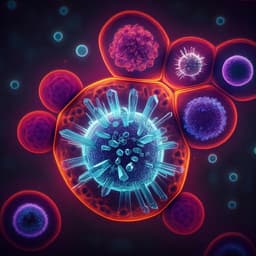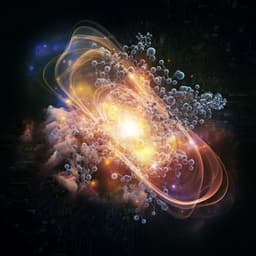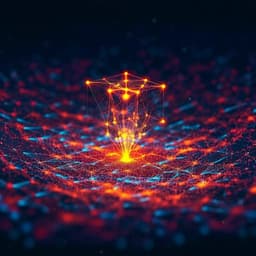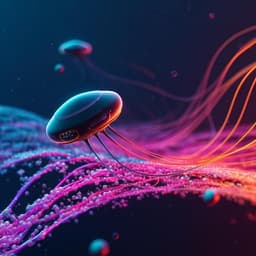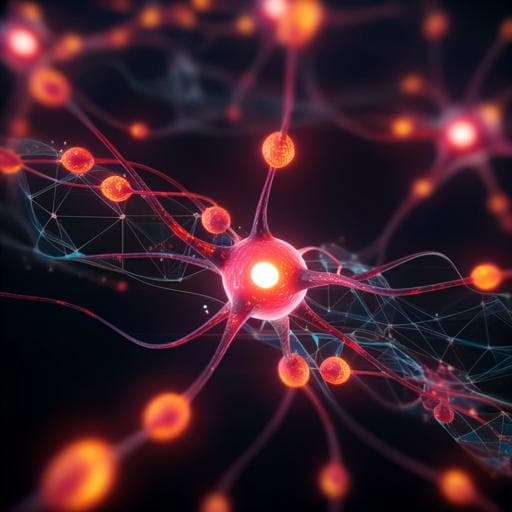
Biology
Fast, efficient, and accurate neuro-imaging denoising via supervised deep learning
S. Chaudhary, S. Moon, et al.
Discover how Shivesh Chaudhary, Sihoon Moon, and Hang Lu have developed NIDDL, a groundbreaking supervised deep-denoising method that enhances calcium trace quality while maintaining high imaging speed and low laser power. This innovative technique opens doors to faster and extended imaging experiments across various biological contexts.
~3 min • Beginner • English
Introduction
The study addresses a central challenge in fluorescent functional imaging: balancing signal-to-noise ratio (SNR) with imaging speed, field of view (FOV), resolution, and permissible laser power to avoid photobleaching and phototoxicity. Existing approaches, including advanced microscopy and unsupervised deep-learning denoising, can mitigate tradeoffs but often require specialized hardware, ultrafast acquisition, large-scale sequential datasets, and video pre-registration—constraints that limit accessibility and performance in common volumetric imaging settings (e.g., C. elegans whole-brain imaging at 3–6 volumes/s). The research question is whether supervised deep-learning denoising trained on small, non-temporally-linked paired datasets can accurately and efficiently recover high-SNR images and preserve temporal neural activity structure to enable high-quality calcium trace extraction from noisy videos across diverse experimental conditions. The purpose is to develop and validate a generalizable, fast, memory-efficient denoising framework that lowers experimental and computational barriers while maintaining high fidelity for downstream analyses.
Literature Review
Recent deep learning–enhanced microscopy methods improve speed-SNR tradeoffs but can require intricate system characterization (e.g., axial light propagation) or specialized light-field setups not widely available. Unsupervised denoising for calcium imaging (e.g., DeepInterpolation, DeepCAD) has shown promising calcium trace recovery in 2D two-photon mouse data, but relies on large training datasets (~100,000 and ~3,500 frames respectively), pre-registered videos, and ultrafast rates; performance degrades at slower rates, implying reliance on temporal redundancy. These models also impose heavy memory requirements. Supervised methods generally attain higher accuracy and better generalizability but have not been applied to video denoising and calcium trace extraction, partly due to challenges in acquiring simultaneous low/high-SNR video pairs or concerns about preserving temporal dynamics when denoising frames independently. Practical deployment depends on model size, inference speed, and memory footprint. This work positions supervised denoising trained on non-temporal paired images as an orthogonal and accessible strategy to overcome these limitations.
Methodology
Framework: Neuro-Imaging Denoising via Deep Learning (NIDDL) is a supervised CNN pipeline trained on small sets (~500–600 pairs) of independently acquired, non-sequential low-SNR/high-SNR image stacks from immobilized samples across strains, laser powers, and sessions. Trained models denoise each volume/frame independently in videos, followed by standard segmentation, tracking, and calcium trace extraction.
Data acquisition: Imaging performed on Bruker Opterra II swept-field confocal with EMCCD. Whole-brain (ZIM504, OH16230): 25–30 z-planes (1 µm spacing), 40× 0.75 NA objective, low vs highest laser power for noisy vs clean images. Ventral cord neurons (OH16230): 20× 0.45 NA ELWD objective, 10 ms exposure, paired low vs high laser power stacks; large FOV and freely moving recordings acquired at low laser power with 20× objectives (stacked z, maximum intensity projections used for denoising). Neurites (GT372 gentle touch; GT386 PVD harsh touch): 40× 0.75 NA objective, 40 z-planes, paired low vs high laser power.
Network architectures and optimization: Evaluated UNet, Hourglass, and DFCAN variants. Selected memory-optimized UNet_fixed and Hourglass_wres with fixed 32 channels at all layers, residual connections within blocks, 4 down- and 4 up-sampling stages, 3×3 kernels (5×5 gave no accuracy gain). These choices reduced parameters and memory footprint, enabling deeper networks and faster training/inference compared to CARE, RCAN, vanilla UNet/Hourglass. Training used Adam (lr=0.001), ReLU, max-pooling/upsampling, on 16–32 GB GPUs with input size typically 512×512×d. Loss functions compared: L1 vs L2; both similar overall, with L1 yielding more stable training and better RMSE/PSNR in whole-brain datasets, L2 slightly better SSIM and preferred for neurites. Training modes compared: 2D (512×512×1), 2.5D (context planes above/below, output center plane), 3D (stack in/out). 2D performed best given memory constraints and noise in adjacent z-planes; 3D required smaller batch sizes and did not outperform 2D.
Video denoising and trace extraction: Whole-brain videos denoised per z-plane and reassembled; segmentation via Gaussian mixture, automated tracking with manual curation; single-pixel and ROI-averaged trace extraction (e.g., 5×5×3 ROI). For ventral cord datasets and freely moving recordings, maximum intensity projections of stacks were denoised; traces extracted at single pixels and ROIs (e.g., 3×3 ROIs), manual tracking used in freely moving animals.
Synthetic and semi-synthetic data: Generated 3D synthetic whole-brain stacks (128×128×30) with simulated nuclei (3D Gaussians), Poisson shot and Gaussian readout noise, across photon count levels (20–1000) to evaluate robustness vs noise. Semi-synthetic videos (512×512×30 over 100 time points) used OpenWorm atlas geometry, activity traces sampled from published datasets; varied photon counts (100–1000) to benchmark SNR recovery.
Accuracy metrics and comparisons: Image metrics RMSE, PSNR, SSIM computed after intensity normalization. Trace accuracy assessed via MAE to ground-truth traces and Pearson correlation. Benchmarked against Median/Gaussian filtering, NLM, BM3D, and deep methods CARE and RCAN using identical training data. Inference runtime compared on GPU (Quadro M4000, 8 GB) and CPU (Xeon E5-1620 v4, 32 GB RAM). Statistical tests used Holm-Bonferroni paired comparisons.
Key Findings
- Model efficiency and speed: Optimized UNet_fixed and Hourglass_wres achieved ~20–30× smaller model size (≈3.77 MB and 3.66 MB) and 3–5× faster inference than CARE/RCAN, with per-image inference times of ≈48.9 ms and 68.7 ms (512×512). Training was 2–3× faster per epoch. On CPU-only inference, NIDDL averaged 1.25 s/image vs CARE 2.67 s and RCAN 7.29 s.
- Data efficiency: Accuracy plateaued with ~500–600 training image pairs (≈25–40 whole-brain stacks), an order of magnitude smaller than DeepCAD (3,500 frames) and vastly smaller than DeepInterpolation (~100,000 frames).
- Image denoising accuracy: On held-out datasets, NIDDL outperformed traditional (Median, Gaussian), advanced non-deep-learning (NLM, BM3D), and deep RCAN methods in RMSE/PSNR/SSIM; CARE achieved similar accuracy but with much larger models and slower inference. NIDDL recovered nuclear structure from very noisy whole-brain images, improving segmentation readiness.
- Generalizability: Models trained on one strain or day generalized well across strains (OH16230, ZIM504) and across independent sessions/days with similar accuracy to within-condition training. Performance was sensitive to laser power differences; accuracy was high when test SNR matched training distribution. Empirically, efficient denoising required a minimum image SNR of ~20.
- Calcium trace recovery (whole-brain): Denoised videos preserved temporal activity structure without introducing artifacts when compared against near-synchronous high-SNR ground-truth videos. Denoised traces had substantially lower MAE and higher Pearson correlation to ground truth than traces from noisy videos. Correlational structure among neurons (e.g., PCA latent dynamics) was restored.
- Large FOV ventral cord recordings: NIDDL enabled detection of neurons and recovery of activity transients at low magnification/low laser power where cells span few pixels. Single-pixel traces from NIDDL-denoised videos matched ROI-averaged traces, whereas in noisy videos ROI averaging still missed many transients.
- Freely moving animals: NIDDL significantly improved single-pixel trace SNR and enhanced correlations between motor neuron activity and local body curvature despite motion, facilitating analyses under low exposure/low power conditions.
- Neurite imaging: With L2 loss preferred, NIDDL recovered complex dendritic structures (e.g., PVD) from noisy images, outperforming non-deep baselines and matching deep methods. Denoising substantially improved segmentation using simple morphological operations. Models trained on one neurite morphology generalized across strains (GT372 vs GT366).
Discussion
The results demonstrate that supervised deep denoising trained on small, non-temporally-linked paired datasets can accurately recover high-SNR images and preserve neural activity dynamics when denoising video frames independently. This addresses the key challenge of extracting reliable calcium traces under practical imaging constraints—low exposure, low laser power, large FOV, and motion—without requiring ultrafast pre-registered videos or specialized hardware. The optimized architectures deliver high accuracy with significantly reduced memory footprint and near real-time inference, enabling broader deployment and potential closed-loop applications. Generalization across strains and sessions indicates that training on diverse stationary samples captures the relevant SNR/structure distributions, supporting reuse across experiments. Sensitivity to laser power underscores the importance of matching SNR distributions or ensuring a minimal SNR (~20) for robust recovery. Collectively, NIDDL lowers experimental and computational barriers for volumetric functional imaging and downstream analyses, improving segmentation, tracking, correlational structure, and latent trajectory recovery from challenging datasets.
Conclusion
This work introduces NIDDL, a supervised deep-learning denoising framework that is fast, memory-efficient, data-efficient, and generalizable for neuro-imaging. Trained on small sets of non-video paired images, NIDDL denoises volumetric recordings frame-wise while preserving temporal structure, enabling accurate calcium trace extraction across whole-brain, large-FOV, and neurite-imaging applications in C. elegans. Compared to existing methods, it achieves comparable or superior accuracy with 20–30× smaller models and 3–5× faster inference, and it functions effectively without ultrafast acquisition or video pre-registration. Potential future directions include extending training datasets to encompass broader SNR/laser power regimes for improved cross-power generalization, deploying NIDDL for real-time closed-loop experiments (e.g., optogenetic feedback), adapting and validating the approach across additional organisms and imaging modalities, and integrating with automated segmentation/tracking pipelines for fully streamlined analyses.
Limitations
- Dependence on paired training data: Although small and easy to acquire on immobilized samples, supervised training requires matched low-/high-SNR image pairs.
- Sensitivity to acquisition conditions: Models generalize across strains and days but are sensitive to laser power/SNR shifts; robust performance requires matching SNR distributions or maintaining a minimal SNR (~20).
- 3D training tradeoffs: Full 3D or 2.5D contexts did not outperform 2D under memory constraints and may require more data; thus, current best performance is with 2D training and frame-wise denoising.
- Architecture scope: DFCAN could not be effectively trained under available memory/data constraints for this task. The approach was validated primarily on confocal datasets and C. elegans; broader modality/organism generalization, while likely, was not exhaustively tested.
Related Publications
Explore these studies to deepen your understanding of the subject.



